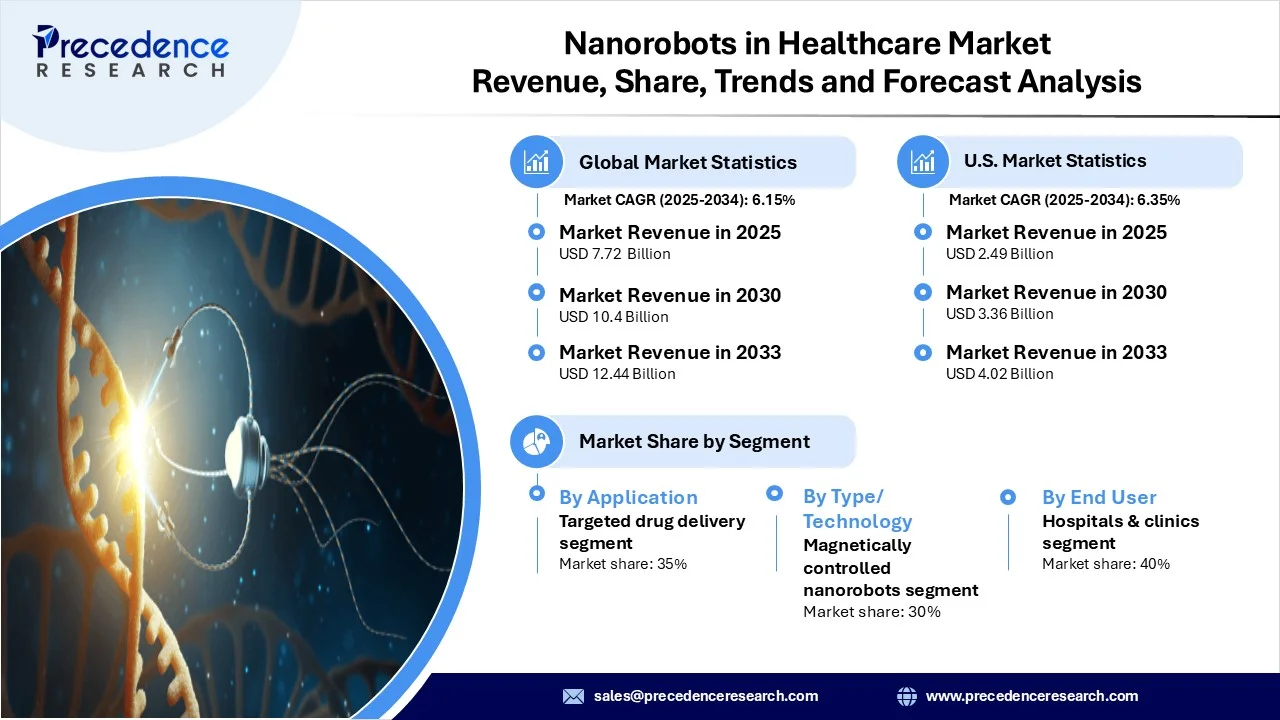Nanorobots in Healthcare Market Revenue to Attain USD 12.44 Bn by 2033
Nanorobots in Healthcare Market Revenue and Trends 2025 to 2033
The global nanorobots in healthcare market revenue reached USD 7.72 billion in 2025 and is predicted to attain around USD 12.44 billion by 2033 with a CAGR of 6.15%. The nanorobots in healthcare market are driven by advancements in nanotechnology, rising demand for precision medicine, and increasing applications in targeted therapies.

Expansion and Catalysts of Nanorobots in Healthcare
Nanorobots in healthcare are small machines designed to execute specific medical operations in the body at the nanoscale; targeted medicine, diagnostics, and cellular repair are examples of nanoscale devices. This market is, driven by technological advancements, rising demand for precision medicine, and increased funding for nanorobotics research.
There is a rise in applications of nanorobots, for example, in cancer treatment, neurological disorders, and tissue engineering, which is encouraging adoption at a quicker pace. Rapid growth in the area of nanotechnology, with research funding from public and private investment, is supporting further expansion.
Segmental Analysis
Application Insights
Targeted drug delivery segment dominated the market as it allows precise delivery of therapeutics for treatment of cancer, cardiovascular diseases, and infections, with minimal side effects.
Theranostics is fastest growing application segment. Combines diagnostics and therapeutics in single systems supporting early detection and immediate response to therapeutics.
Type / Technology Insights
Magnetically controlled nanorobots are dominant type of nanorobots. Guided by magnetic fields generated externally to ensure precise navigation and therapeutics delivery.
Others fastest growing technology segment includes ultrasound-driven, hybrid actuation, and multifunctional nanosystems.
End-User / Sector Insights
Hospitals & Clinics are the dominant end user as rapidly adopting nanorobots for advanced therapies or procedures with minimal invasiveness.
Diagnostic & imaging centers fastest growing end user segment using nanorobots for real-time imaging, molecular diagnostics, and precision monitoring
Regional Analysis
North America is the dominant market for nanorobots in healthcare, owing to its experienced research infrastructure, partnerships with academic-industry, and stable funding for R&D. In addition, its existing regulatory policies and hospitals that are willing to pioneer with early-comer products promote the clinical adoption of targeted drug delivery and minimally invasive diagnostics. The venture capital community and existing medtech ecosystem help shorten commercialization timelines and support pilot studies in both the U.S. and Canada.
Asia Pacific is the fastest growing region for nanorobots in healthcare due to increased manufacturing, greater investments in R&D and patient populations seeking affordable, innovative therapies. Government agencies in China, India, South Korea and Singapore are prioritizing funding for nanotech initiatives. At the same time, as clinical trials increase and private investment grows in Asia Pacific, routine scale-up and adoption across healthcare systems will occur even faster.
Nanorobots in Healthcare Market Coverage
| Report Attribute | Key Statistics |
| Market Revenue in 2025 | USD 7.72 BIllion |
| Market Revenue by 2033 | USD 12.44 BIllion |
| CAGR from 2025 to 2033 | 6.15% |
| Quantitative Units | Revenue in USD million/billion, Volume in units |
| Largest Market | North America |
| Base Year | 2024 |
| Regions Covered | North America, Europe, Asia-Pacific, Latin America, and Middle East & Africa |
Key Players in the Nanorobots in Healthcare Market
- Acuity Nanomedicine
- NanoRobotics Labs
- Aethon Inc.
- Innova Biosciences
- Sirakoss
- VectorNano
- MicronRobotics
- Emerging Nanomedicine Technologies (ENTech)
- RoboNano Health
- Advanced Nanotech Solutions
- Bionano Robotics
- SkyNano Tech
- Nanobio Robotics Inc.
- Sona Nanorobotics
- NanoMedsense
- MagnetoNano Systems
- DNA Origami Labs
- Theranostic Nanorobotics
- Precision NanoHealth
- NanoDiagnostics Inc.
Recent Developments
- In November 2024, Theranautilus, a pioneering deep-tech startup specializing in nanorobotic solutions for healthcare, has announced raising US$1.2 million in a seed funding round. (Source: https://www.businesswire.com)
Get this report to explore global market size, share, CAGR, and trends, featuring detailed segmental analysis and an insightful competitive landscape overview @ https://www.precedenceresearch.com/sample/6879
You can place an order or ask any questions, please feel free to contact at sales@precedenceresearch.com |+1 804 441 9344